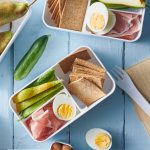The following post was written by USC Dietetic Intern Jessica Myers. Be sure to follow her on Instagram @myersxhealth .
If you are following a low sodium diet, you might find it difficult to adhere to your dietary plan while still being able to go out and enjoy a meal. Sometimes it feels like many restaurants use salt as if it’s the first ingredient in most of their recipes. Am I right?!
The American Heart Association (AHA) recommends no more than 2,300 milligrams of sodium per day and currently, the average American eats more than 3,400 mg of sodium everyday. Some of the dishes you may be ordering can even have a full day’s worth of sodium in it alone! Of course cooking meals at home is key to good health but who wants to deprive themselves from never eating out again? (No one!) So below I have a few tips you can use when wanting to dine out while adhering to a low sodium diet.
1.SCIP stands for Smoked, Cured, Instant, and Processed and if you see any of these words on the menu, be sure to SKIP it! Dishes that contain these types of foods are high in sodium and may not be the best option for you. Some examples of this are smoked salmon and cured meat, which you can find on many charcuterie boards. Bacon is also something you might want to avoid as it is very high in sodium.
Avoid the SCIP’s and look for words on the menu such as grilled, broil, or steamed. These cooking methods tend to use less salt which is a much better alternative.

2. Speak Up! (But do it nicely!) If you are comfortable doing so, communicate with your server regarding your low sodium diet. Letting your server know that you are adhering to a low sodium diet will allow them to accommodate you better and maybe even speak to the chef to prepare a lower sodium menu item for you. In addition, feel free to ask your server questions to get to know more about the food they serve or even a particular dish. Some questions you can ask are “does this dish come with any sauces?” or “can you skip any seasonings that this dish may have?”

3.Knowledge is key! Know what ingredients are typically higher in sodium so you can be aware of what foods may not be the best option for you. Some examples of high sodium foods are cheeses, olives, bread, pre-made sauces, and deli meats. Either skip these dishes or ask the waiter to remove particular items from your dish. Another option is to check ahead of time to see if the restaurant has nutrition information regarding the menu items online. This way you can plan out your meal beforehand and be better prepared.
4.Go easy on the dressings and sauces. Sorry to break it to you (I love them just as much as you do!) but dressings and sauces contain a large amount of sodium which we should be cautious of. If you can, ask your server to skip them or you can alternatively ask for them on the side, so you can control how much you are going to have. Ketchup and salsas are some examples of high sodium condiments. The pico de gallo at Chipotle contains 550 mg of sodium per 3.5 ounces which is equivalent to about a scoop of it. You can also replace dressings and sauces with lemon wedges, vinegar, and/or olive oil. Better yet, try bringing your own low sodium condiment with you to better prepare!
5.Don’t be afraid to alter your meal!! It will be hard to find a menu item that works perfectly for you and trying to look for the “perfect” dish will most likely stress you out. Rather than doing so, look for a meal that looks appealing and appetizing to you and adjust it to fit as a lower sodium option. For example, bread is surprisingly a high source of sodium. If wanting to order a sandwich or burger, try asking for it as a lettuce wrap also known as “protein style” or you can alternatively ask for an open-faced sandwich, using only 1 slice of bread or bun.
Some other tips that can help make dining out on a low sodium diet easier are avoiding pickled food items as most pickled foods tend to be extremely high in sodium such as pickles, sauerkraut, and kimchi. Potato chips and fries are also not the best options for those following a low sodium diet so opt for a fruit salad, side salad, or steamed vegetables instead. Lastly, most farm-to-table or locally-owned restaurants make food to order and therefore are more accommodating to altering your meal, so next time you go out to eat, make sure to try out a local restaurant that you may have not tried before!

I hope the tips I have listed help you feel more comfortable dining out while adhering to your low sodium diet.





